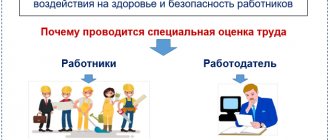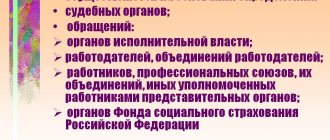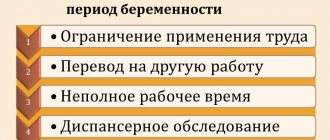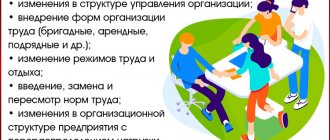Why is a special assessment needed?
In addition to the formal reason, there is also a moral one: the commission determines the hazard class in which a particular person has to work. The commission's findings help create specific recommendations for occupational safety and health. If the requirements of the legislator are met, the likelihood of accidents and occupational diseases is reduced. After determining the hazard class, wages, pension contributions, and material compensation are optimized.
A timely special assessment procedure protects the employer from fines and civil liability, and allows the employee to maintain health or receive adequate financial compensation and create proper working conditions.
What is the time frame for the procedure?
The legislation provides for the following frequency of conducting SOUT:
- for a job created for the first time - up to 12 months;
- if the workplace has been modernized (different equipment has been used, technology has been changed) - within a year;
- after the previous special assessment has expired, on average it is 5 years.
Features of carrying out SOUT in new organizations
SOUT, the terms of which are legally defined as 1 year, are mandatory for all enterprises. Legal entities and individual entrepreneurs are in the same conditions. The procedure is not required in the following cases:
- the employee works from home or remotely;
- there is an office or workshop, but there are no people in it.
If the premises are rented, then a special assessment is carried out by the person who works in this premises.
New jobs include jobs that existed previously, but where working conditions have changed - new technology or new equipment has appeared. This assessment is carried out outside the plan and is required before the end of the first year. The procedure is not needed in cases where the changes did not affect the technological process, but the formal characteristics have changed: full name, position or name of the enterprise after the reorganization. If the employer decides that the new location does not require a special assessment, then a local protocol is drawn up about this, which is agreed in writing with the trade union.
Validity period of SOUT, when is a renewing required?
RS of working conditions is mandatory for every organization that has employees.
The study is carried out every 5 years. The effect of the CO is extended if there are no harmful factors and the labor processes remain the same.
Organizations create a schedule of assessment activities. Frequency: 60 months. New measurements must be taken in advance. The data must be ready for the last date of validity of old documents.
If the number of jobs has increased or the work environment has changed, additional monitoring is carried out. Only changed conditions are examined. The document remains valid for the entire five-year period.
Certification cards have an expiration date of 5 years. All appraisal documentation is stored for 45 years. If the labor process is difficult and harmful - 75 years. The period is established by law (Order of the Ministry of Culture No. 558 of August 25, 2010).
How is SOUT carried out in the presence and absence of harmfulness?
The frequency of a special assessment of working conditions depends on what harmful factors there are and to what class they are classified.
Production without harmful conditions
This is 1 (optimal) or 2 (permissible) hazard class, when the employee’s health is not in danger. The declaration is valid for 5 years.
If during this time no accidents or occupational diseases occur, the declaration is automatically extended for the next 5 years. In the event of an occupational illness or accident, an investigation is carried out. If there is no fault of the third party, the declaration is terminated and an extraordinary special assessment is assigned.
Production with harmful factors
These are recognized as conditions when hygienic standards are exceeded: class 3 includes 4 subclasses (increasing harmfulness from 1st to 4th), 4 - work in specific conditions creates a threat to life or leads to the formation of occupational diseases.
What is the frequency of conducting a special assessment of working conditions in these cases? The law provides for a procedure for conducting it once every 5 years, if there have been no changes in the nature of work. However, a new declaration is prepared and submitted by the end of the 5-year period; breaks are unacceptable.
The relationship between workplace certification and SOUTH
SOUT replaced workplace certification, but the meaning remained the same. With a valid AWP, there is no need to conduct a new report until the end of the previous declaration. An exception is the organization of an unscheduled assessment, due to the presence of certain factors that have already been mentioned.
Note ! Conducting SOUT is allowed after the expiration of the AWS period.
The difference is that the AWP directly covers working conditions in the workplace, while the special assessment takes place on a larger scale, touching on the costs of social security for employees and issues of improving places.
It is more profitable for employers to carry out SOUT, since they are interested in it - it allows them to reduce labor costs by reducing additional insurance payments in the Pension Fund.
Deadlines provided for unscheduled SOUT
What are the deadlines for conducting a special assessment of working conditions outside the plan? The legislation provides for only two terms: 6 and 12 months.
Situations in which there are 6 months to carry out special assessment work
It is necessary to keep within 6 months if:
- there is a regulation on SOUT;
- the use of new production components that potentially threaten human health began;
- new protective equipment, personal or collective, was used - reconstruction, filters, safe machines, special clothing;
- an accident was recorded that was caused by working conditions;
- the employee received an occupational illness, which was documented by doctors;
- there is a request or demand from the trade union.
The procedure for assessing working conditions is carried out to achieve results and eliminate hazards that worsen people’s health.
Situations in which 1 year is allotted for a special assessment
The procedure must be carried out within a year in the following cases:
- the number of jobs at the existing enterprise has increased;
- The technological chain has changed, equipment has been added.
The conditions are the same as for SOUT for newly created organizations.
Conducting a special assessment of working conditions
TABLE OF CONTENTS
• The essence of a special assessment of working conditions • When is an unscheduled SOUT required?
• Who needs to conduct • Who conducts the special assessment?
• What is subject to special assessment? • Results of a special assessment of working conditions
• Timing of the planned SOUT • Responsibility for violations (fines)
Since the beginning of 2014, Federal Law No. 426-FZ dated December 28, 2013 (hereinafter referred to as the Law on SOUT) has been in force. Its provisions completely abolished the certification of workplaces, and instead introduced a new procedure for analyzing harmful factors at work - a special assessment of working conditions (hereinafter referred to as SOUT).
Despite the fact that the transition period is still ongoing, and for many the deadline for carrying out the special labor inspection will be December 2020, labor inspectors are already conducting regular and unscheduled inspections, identifying thousands of violations. To avoid incurring fines and penalties, employers should understand the innovations as early as possible.
The essence of a special assessment of working conditions
SOUT, in essence, is a check and assessment by independent experts of working conditions at predetermined workplaces. If work is associated with harmful and dangerous influences, a specialized organization makes the necessary instrumental measurements and, having established the influence of conditions on people working there, assigns the workplace one of the possible classes:
- Optimal; acceptable;
- Harmful; dangerous.
The amount paid by the employer for its employees to the Pension Fund of the Russian Federation, as well as the amount of benefits entitled to employees (additional leave, shortened working hours, etc.) depends on the results of the SOUT.
Reducing the impact of detected harmful factors in the future can minimize the established additional tariff and even reduce it to zero, and will also reduce the employer’s costs for compensation and guarantees for employees engaged in hazardous production. It turns out that the better the working conditions of employees, the less the employer will have to pay.
Who needs to conduct SOUT?
The Law on SOUT places the responsibility for financing and organizing the special assessment process on all employers - legal entities and individual entrepreneurs who employ employees. Accordingly, a special assessment of working conditions is not required:
1) Entrepreneurs operating without hiring employees;
2) Employers - individuals.
What is subject to special assessment?
The working conditions of employees are assessed based on the physical parameters of their workplaces, i.e. places under the control of the employer, to which employees need to arrive to perform their job duties. According to the Law on Specialized Labor and Employment, the positions of all employees must be assessed, except those who:
- works for employers - individuals;
- works from home;
- performs work remotely.
Working conditions are checked at all workplaces, taking into account their similarity. Jobs that are considered similar are:
- are located in similar areas with the same lighting, ventilation and heating conditions;
- equipped with the same production equipment and personal protective equipment;
- involve the work of employees with the same positions and job functions.
Despite the fact that only a fifth of similar workplaces are subject to inspection (but not less than two), the results of a special assessment of working conditions apply to all similar workplaces.
Timing of the planned SOUT
From 2014 to 2020, legislators have provided for a transition period, during which the results of previously conducted certification of workplaces will be valid and a phased implementation of a set of assessment measures will be possible. However, there are workplaces where SAS needs to be carried out immediately. The Law on SOUT lists the deadlines given to employers to obtain the primary results of a planned special assessment for various groups of jobs:
1) At workplaces certified before the entry into force of the Law on SOUT , a special assessment is carried out until the end of the validity of the certification results, i.e. within five years from the date of its implementation.
Important! At the employer’s initiative, it is possible to conduct a planned special assessment ahead of schedule. This may be required in cases where working conditions at workplaces have been improved since the certification, and based on the results of the assessment and assessment, the employer plans to reduce its costs of providing guarantees and compensation to preferential categories of employees.
2) At workplaces that are active and not previously subject to certification:
a) A special assessment is carried out until December 31, 2020, if the type of these jobs is not listed in clauses 1, 2, part 6 of art. 10 of the Law on SOUT. This list includes jobs of employees whose duties are related exclusively to:
- working on computers;
- periodic use of printers, copiers, and household appliances.
However, the process of organizing SOUT should be carried out in stages and not be postponed until the end of 2020. After all, the rush demand for the services of experts and the workload of specialized organizations - appraisers at the end of the transition period can create conditions in which obtaining the results of the assessment system within the specified time frame will become impossible.
b) A special assessment is carried out immediately if the type of these jobs is included in clauses 1, 2, part 6 of art. 10 of the Law on SOUT. Such workplaces include those where work provides employees with:
- early retirement in old age;
- guarantees and compensation in connection with dangerous and harmful working conditions.
When the five-year period of validity of the results of the primary SOUT ends, there is a need to conduct a re-assessment, but only for those employers who had previously identified dangerous or harmful working conditions. For employers who have a declaration of workplace compliance with established standards (of course, if working conditions have not changed and remain safe), the effect of the results recorded by the primary SOUT is extended for the next five years, reducing the employer’s expenses for carrying out special assessment activities.
If no circumstances arise that cancel the validity of the declaration, it, according to experts, will continue to work, because the Law on SOUT does not provide for the number of possible extensions. However, judicial practice has not yet been formed on this issue and it is quite possible that different opinions may soon arise.
In what cases is an unscheduled SOUT required?
The transition period does not apply to unscheduled special assessments, which means that now all employers who experience the events listed in Art. 17 of the Law on SOUT, within six months they are required to carry out unscheduled measures to assess working conditions. Conditions that cause unscheduled emergency conditions include:
- the creation of new jobs, including only for registered employers;
- changes in the production process, composition of materials used and other factors that may affect the harmfulness and danger of work for workers;
- an employee’s occupational disease or industrial accident, the occurrence of which is associated with dangerous working conditions;
- union demand;
- instructions from the labor inspectorate.
Who conducts a special assessment of working conditions?
To identify potentially dangerous factors, measure deviations from the norm, as well as to document the results of the special assessment system, the employer must engage a specialized organization on the basis of a civil law contract. In addition, it is possible to simultaneously conclude a voluntary liability insurance agreement in order to minimize the risk of damage during the process of measurements, research and other aspects of the experts’ work.
Taking into account the requirements of the Law on Special Assessment of Expertise regarding the independence of experts, restrictions are imposed on the list of persons allowed to conduct a special assessment. For example, the founder of the organization being inspected or his close relative cannot conduct an audit.
Specialized organizations must also comply with the conditions prescribed in the Law on SOUT, compliance with which is confirmed by certification of the Ministry of Labor of the Russian Federation and inclusion in a special register open for review on the website www.rosmintrud.ru . In particular, until December 2018, this register will include companies that were previously admitted to certification of workplaces and have an accreditation certificate valid as of the current date.
Before concluding an agreement on carrying out SOUT with any company, the employer must check its compliance with all legal requirements. Otherwise, the results of the special assessment of working conditions may be canceled by the labor inspectorate, and the employer will have to bear the costs of conducting a repeat, unscheduled assessment.
Results of a special assessment of working conditions
The results of the SOUT are compiled in the form of a report from an expert organization in a form approved by the Ministry of Labor. The document reflects a list of specific workplaces and the classes and subclasses of working conditions established for them. The results of the SOUT become effective from the date the report is signed and oblige the employer to:
- transfer additional contributions to the Pension Fund (for classes “harmful” - from 2 to 7% and “dangerous” - 8%);
- provide the necessary guarantees and compensation to employees;
- provide workers with the necessary protective equipment;
- carry out activities that influence the minimization and elimination of the harmfulness and danger of production factors;
- exercise control over maintaining the safety of workplaces included in the “optimal” and “permissible” classes.
Within the next 30 calendar days, all employees whose workplaces were inspected during the special assessment must be familiarized with the report. If an employee does not agree with the results, he has the right to request a state examination of his workplace. If the results of the assessment system do not satisfy the employing organization, it can submit an application to the Ministry of Labor and Social Protection, appeal the unfounded or inaccurate results of the inspection and conduct a second special assessment.
In addition, within the next month, the results of the SOUT must be posted by the employing organization on the official website (if available). The territorial body of the FSS is notified within the deadlines provided for the submission of current reports, and the information is submitted by inclusion in section 10 of form 4-FSS.
Responsibility for violations in the field of SOUT
In the first year of operation of the Law on Special Labor Laws, more than 23 thousand were recorded, and in the first half of 2020 - over 11 thousand cases of non-compliance with labor legislation. According to the Federal Labor and Employment Service, which analyzed the violations identified, the most common employer misconduct is:
1) Failure to carry out special assessment procedures in cases where it is necessary;
2) Failure to communicate the results of the special operational assessment to employees;
3) Violation of the procedure for conducting SOUT in terms of:
- non-involvement of a specialized organization;
- absence of a commission or non-involvement of workers in its composition;
- analysis of not all eligible jobs;
4) Lack of proper documentation of the results of a special assessment of working conditions;
5) Failure to provide adequate guarantees and compensation based on the assigned classes of working conditions.
Both the organization itself that committed the offense and its officials (manager, occupational safety specialist or other person who, by virtue of the position or order of the director, is entrusted with the responsibility for carrying out the special labor safety system) can be held accountable for violations in the field of SAW. Moreover, the application of punishment to a legal entity can be carried out simultaneously with the holding of responsible employees to administrative responsibility, which comes from the analysis of Part 3 of Art. 2.1 Code of Administrative Offenses of the Russian Federation.
Administrative punishment for failure to carry out or violation of the procedure for organizing SOUT is determined in accordance with Art. 5.27.1 of the Code of Administrative Offenses of the Russian Federation, and its shape and size depend on a number of factors:
- in relation to whom it is applied (legal entity, individual entrepreneur or official);
- primary or repeated prosecution;
- absence of a threat to life and health (warning or fine) or harm to employees (suspension of activities and disqualification of persons) due to the employer’s misconduct.
In particular, the fines are provided for:
- For organizations – 60-80 thousand rubles. for primary and 100-200 thousand rubles. in case of repeated offense;
- For individual entrepreneurs and officials – 5-10 thousand rubles. for primary and 30-40 thousand rubles. upon repeated offence.
When a violation entails a threat to human health or an accident, punishment can be applied in the form of suspension of the activities of a legal entity or individual entrepreneur for 90 days, and officials held accountable are disqualified for a period of one to three years.
Conclusion
The state tries to protect its citizens and provide them with certain rights, including the right to safe work. According to statistics, about 40% of existing jobs are associated with risk factors for health and life. By introducing a mandatory assessment of the harmfulness and danger of working conditions, legislators minimize the likelihood of injuries or illnesses received at work.
I am glad that when carrying out state regulation in the field of labor protection, not only “sticks” were provided in the form of fines and penalties for failure to comply with the requirements of the Law on Labor Safety, but also “carrots” that provide a bona fide employer with a minimum of additional costs and the constant extension of the declaration of conformity. In addition, for an employer who has organized the SOUTH system in a timely and high-quality manner, even reports to the state information system can be sent by a specialized company that carried out the assessment.
Post-assessment activities and timeframes
Once the special assessment report is approved, the employer has obligations towards its own employees and third parties. The organization that conducted the SOUT is notified of the approval of the report within 3 days.
Employees must be familiarized with the results of the special assessment within 30 calendar days, and everyone’s signature is required. Within the same period - 30 calendar days - the result of the SOUT should appear on the website in the public domain. Measures that reduce or eliminate industrial hazards are indicated here.
Deadline for compiling the OHS report
A report on this event is drawn up strictly in a unified form, by an occupational safety specialist or other authorized person. Document approval takes place in several stages:
- drafted by an expert;
- familiarization by the employer;
- agreement with the commission;
- approval by the employer.
Sample
After the specialist who conducted the assessment has filled out and signed the form, it is submitted to the employer for review. The next step is the study of the report by the commission members. The duration of signing by this group is not regulated by law. But after approval, a three-day period begins for the director to approve the report. After signing, the new assessment results come into force.
How long should special assessment materials be stored?
There are different deadlines for reporting, storage and action.
Report deadline
Simultaneously with the formation of the commission, an order from the employer is issued, which stipulates the deadlines for drawing up the report.
Report storage period
For production facilities where no hazards have been identified (classes 1 and 2), the shelf life is 45 years. For enterprises with hazard classes 3 and 4, the period increases to 75 years. If the enterprise has changed the harmfulness of production from optimal and acceptable (classes 1 and 2) to harmful and dangerous (classes 3 and 4), then the shelf life is counted from the moment of the last SOUT.
Validity period of SOUT materials
The validity period of the SOUT in the organization is the same as the validity period of the declaration submitted to the labor inspectorate. Both of these periods correspond to the duration of the hazard class that was established during the last special inspection.
What is the responsibility for untimely implementation of special assessment and assessment work?
According to clause 1, part 2, art. 4 of the Law, the employer is obliged to ensure that special assessments are carried out within the established time frame, and this also applies to unscheduled assessments. He is also obliged to provide all possible assistance in the form of providing all necessary documents, information and explanations to the organization hired to carry out the special assessment.
In case of failure to fulfill the obligations to carry out special labor safety measures in terms of compliance with occupational safety standards, the guilty person will be charged, in accordance with Part 2 of Art. 5.27.1 of the Code of Administrative Offenses of Russia, penalties are imposed. Officials and individual entrepreneurs face a fine of up to 5,000 rubles, and employing companies - up to 80,000 rubles.
So, planned SOUT should be carried out at enterprises and individual entrepreneurs with hired employees at least once every 5 years. However, if a number of conditions arise, such as the creation of new places to perform work duties, receipt of an order, actual evidence of violation of occupational safety requirements, etc., it is necessary to carry out an unscheduled special assessment. This is given from six months to a year, depending on the nature of the factors that may affect the health of employees.
You can find more complete information on the topic in ConsultantPlus. Full and free access to the system for 2 days.
Example of a special assessment report
The report consists of expert assessment and tabular data. Required items:
- comprehensive information about the enterprise, including a copy of accreditation;
- description and list of workplaces indicating the hazards for each;
- protocols of measurements performed indicating the measuring equipment;
- scorecards;
- a statement containing all data indicating hazard classes;
- if necessary, a description of measures to reduce harm;
- expert opinion.
Each member of the commission puts a personal signature on the report. Sequence of conduct and responsibility in the video:
Timing of SOUTH in the organization
The entire process takes 25-30 days , excluding weekends and holidays.
Everything is done in stages:
- An order is issued, a commission is appointed, and a list of jobs is approved.
- An agreement is concluded with a licensed organization that operates in the field of CO.
- The company is carrying out the necessary work. A report on the results of the research is prepared.
- The documents are handed over to the commission for study and signing of the final report.
- Enterprise employees receive research maps for review (period - 30 days).
- The final data enters the unified information system for recording the results of assessment of labor conditions.
The employer is required to submit assessment information to the Federal Social Insurance Fund of the Russian Federation.
The time period for submitting a completed declaration to the State Labor Inspectorate is 1 month from the date of approval of the inspection report.
Timely measures taken to assess the technical requirements will protect the company from penalties from the Inspectorate in the event of an inspection.










